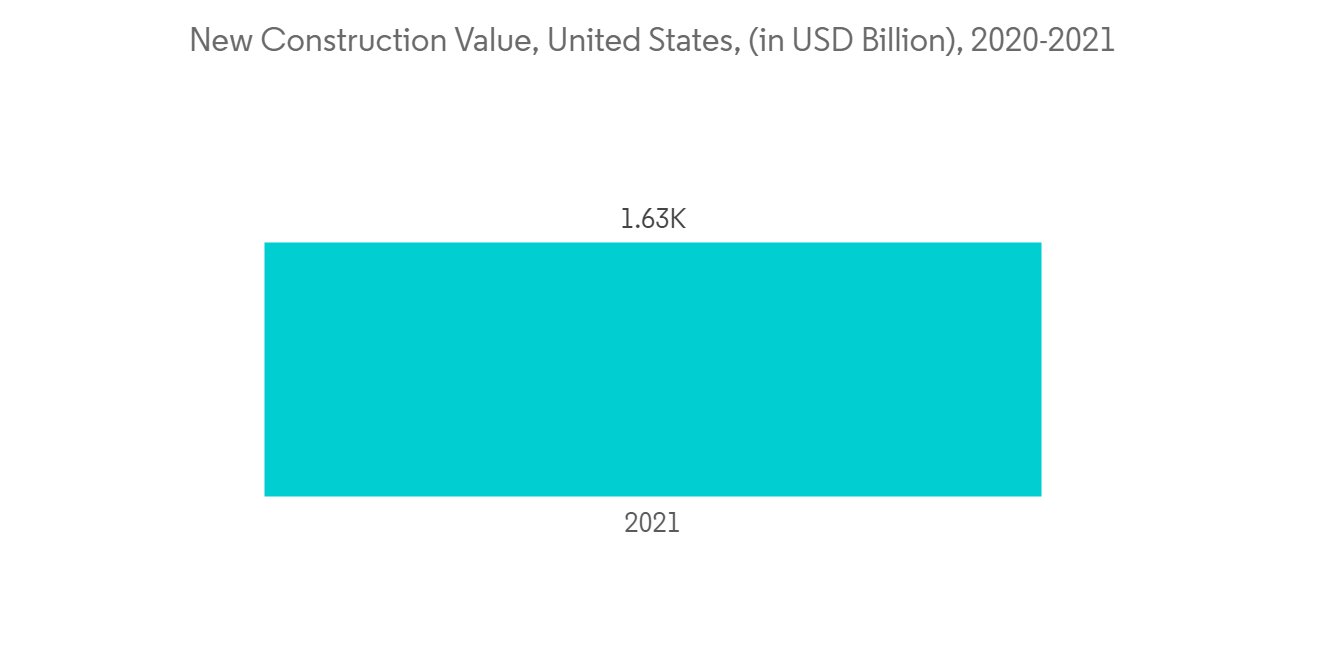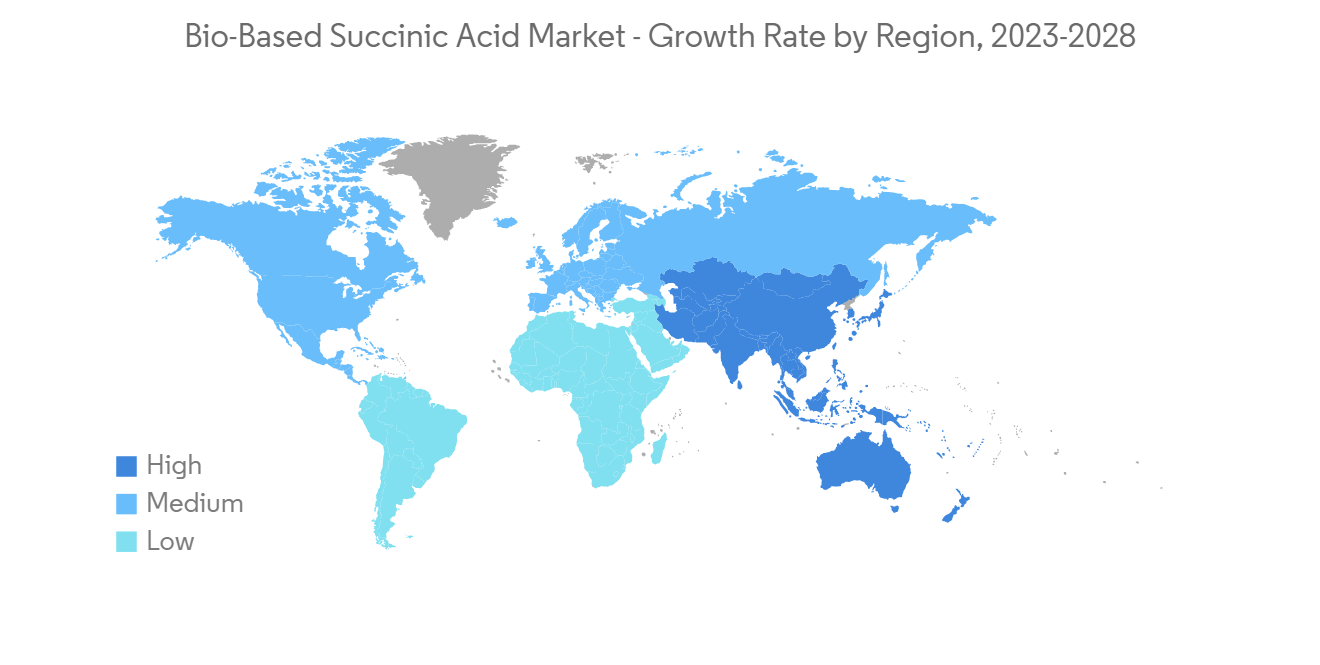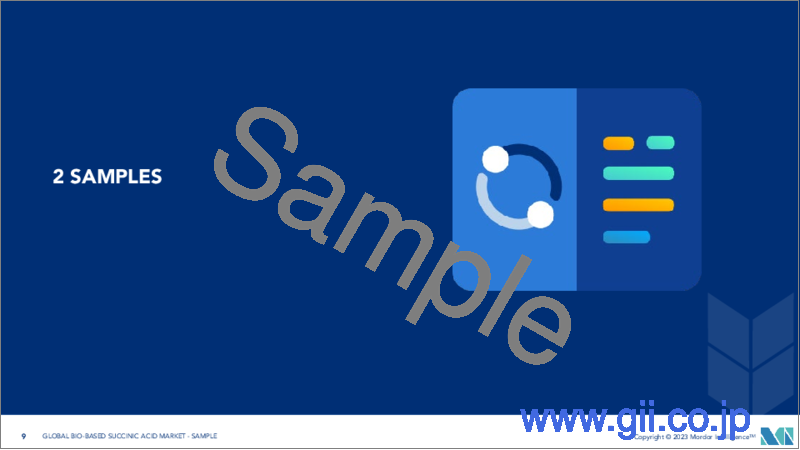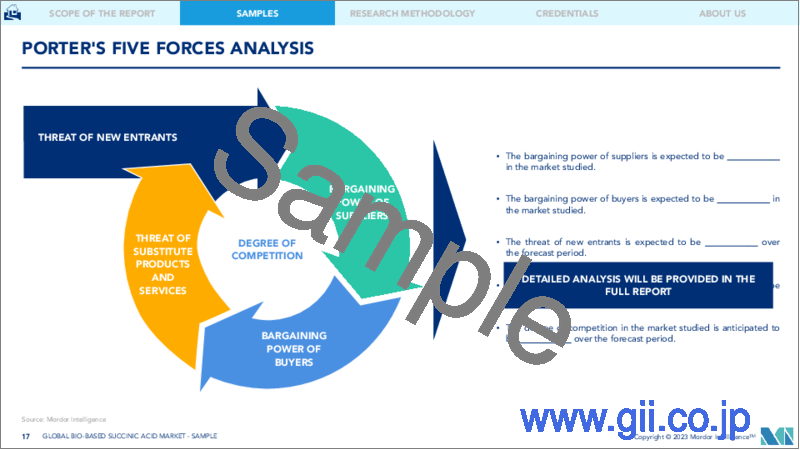|
|
市場調査レポート
商品コード
1272696
バイオコハク酸市場- 成長、動向、予測(2023年-2028年)Bio-Based Succinic Acid Market - Growth, Trends, and Forecasts (2023 - 2028) |
||||||
|
● お客様のご希望に応じて、既存データの加工や未掲載情報(例:国別セグメント)の追加などの対応が可能です。 詳細はお問い合わせください。 |
|||||||
価格
| バイオコハク酸市場- 成長、動向、予測(2023年-2028年) |
|
出版日: 2023年04月14日
発行: Mordor Intelligence
ページ情報: 英文 120 Pages
納期: 2~3営業日
|
ご注意事項 :
本レポートは最新情報反映のため適宜更新し、内容構成変更を行う場合があります。ご検討の際はお問い合わせください。
- 全表示
- 概要
- 目次
概要
バイオコハク酸市場は予測期間中に2%未満のCAGRで推移すると予測されます。
主なハイライト
- COVID-19は、2020年の市場にマイナスの影響を与えました。しかし、市場は2022年に流行前のレベルに達し、今後も安定した成長が期待されます。
- 化石燃料の価格不安、カーボンフットプリントの増加、グリーンケミカルの採用増加により、バイオコハク酸の需要が急増すると予想されます。一方、バイオコハク酸はコストが高く、抽出に時間がかかるため、市場の拡大には制約があります。
- さらに、バイオコハク酸から作られる持続可能な染料は、将来的に市場機会をもたらすと予想されています。アジア太平洋地域は、予測期間中、バイオコハク酸の高い需要を遂げると予想されます。
バイオコハク酸の市場動向
産業用セグメントが市場を席巻
- バイオコハク酸は、プラスチック、ポリウレタン、溶剤、コーティング、潤滑剤、その他さまざまなものを作るための中間体として、幅広い産業用途で使用されています。バイオコハク酸から作られる可塑剤は、耐熱性を持たせるために床材や一般用途、食品包装などに使用されています。さらに、この環境にやさしいコハク酸は、樹脂、コーティング剤、インクの製造にも広く使用され、いくつかの産業用途に使用されています。
- バイオコハク酸は、接着剤、溶剤、シーラント、樹脂、コーティング剤、ポリマーなどの製品を作るために、さまざまな産業用途で広く使用されています。このような製品は、建設分野で広く使用されています。
- このため、建設業界の拡大により、バイオコハク酸の需要が急増すると予想されます。例えば、米国国勢調査局によると、米国で実施された新規建設の年間金額は、2020年の1兆4,996億米ドルに対し、2021年には1兆6,264億米ドルを占めています。
- 飲食品、消費財などの業界では、新製品の開発、生産量の増加、二酸化炭素排出量の削減を目的とした魅力的な包装材への転換が続いており、接着剤を製造するバイオコハク酸の需要を高めています。例えば、インドのパッケージング部門は、接着剤の総使用量の約67%を占める、最も高いエンドユーザー部門です。
- 様々な製品の製造にバイオコハク酸が使用されるようになったことで、今後数年間は市場の成長が期待されます。

アジア太平洋が最も速い成長率を示す
- アジア太平洋地域は、過去数年間、最大のポリアミド市場を占めています。アジア太平洋地域のさまざまな国で成長している医薬品、パーソナルケア、塗料、コーティングなどの産業が、調査した市場を牽引しています。都市化の進展により、バイオコハク酸の需要はさまざまな産業で増加しています。
- 接着剤、溶剤、シーラント、樹脂、コーティング、ポリマーなどの製品は、バイオコハク酸を使用して製造されています。2021年度には、インドで約1,210万メートルトンのポリマーが製造されました。インドの非常に多様な化学産業は、約8万品目を生産しており、バイオコハク酸の需要の増加を増強しています。
- コハク酸の主要な工業製品は、1,4-ブタンジオール(BDO)です。BDOとそのバイオコハク酸誘導体は、産業界で最も使用されている製品です。エンジニアリングプラスチックやポリウレタンシステムなどの中間体として使用されています。さらに、BDO、ポリブチレンコサクシネート(PBS)、可塑剤(ポリプロピレンなど)、ポリエステルポリオールなどの新しい用途により、予測期間中にバイオコハク酸の消費が増加すると予想されています。
- インドでは、リライアンス・インダストリーズのポリプロピレンの生産能力が2022年に3,165キロトンに達しました。これは、インドのポリオレフィン生産能力の半分以上を占め、同地域の市場成長を支えています。
- したがって、上記の理由により、アジア太平洋は予測期間中に高い成長を遂げると予測されます。

その他の特典:
- エクセル形式の市場予測(ME)シート
- 3ヶ月間のアナリストサポート
目次
第1章 イントロダクション
- 調査の前提条件
- 本調査の対象範囲
第2章 調査手法
第3章 エグゼクティブサマリー
第4章 市場力学
- 促進要因
- グリーンケミカルの採用拡大
- その他の促進要因
- 阻害要因
- バイオコハク酸のコスト上昇
- その他の制約事項
- 産業バリューチェーン分析
- ポーターのファイブフォース分析
- 供給企業の交渉力
- 消費者の交渉力
- 新規参入業者の脅威
- 代替品の脅威
- 競合の度合い
第5章 市場セグメンテーション(金額ベース市場規模)
- アプリケーション
- 産業用
- 医薬
- パーソナルケア
- 塗料・コーティング
- その他の用途
- 地域
- アジア太平洋地域
- 中国
- インド
- 日本
- 韓国
- その他アジア太平洋地域
- 北米
- 米国
- カナダ
- メキシコ
- 欧州
- ドイツ
- 英国
- イタリア
- フランス
- その他欧州
- 南米
- ブラジル
- アルゼンチン
- その他南米地域
- 中東およびアフリカ
- サウジアラビア
- 南アフリカ
- その他中東とアフリカ
- アジア太平洋地域
第6章 競合情勢
- M&A、ジョイントベンチャー、コラボレーション、契約など
- 市場シェア(%)**/ランキング分析
- 主要企業が採用した戦略
- 企業プロファイル
- BASF SE
- DSM
- Mitsui Chemicals, Inc.
- Mitsubishi Chemical Corporation
- Roquette Freres
- Technip Energies N.V.
- Corbion
第7章 市場機会および将来動向
- バイオコハク酸から作られる持続可能な染料
目次
Product Code: 55696
The market for bio-based succinic acid is projected to register a CAGR of less than 2% during the forecast period.
Key Highlights
- COVID-19 negatively impacted the market in 2020. However, the market reached pre-pandemic levels in 2022 and is expected to grow steadily in the future.
- The price uncertainty of fossil fuels, the increase in carbon footprints, and the increasing adoption of green chemicals are expected to surge the demand for bio-based succinic acid. On the other hand, the market's expansion is constrained by the higher cost of bio-based succinic acid and the prolonged extraction procedures.
- Further, sustainable dyes made from bio-succinic acid are anticipated to present a market opportunity in the future. The Asia-Pacific region is expected to witness high demand for bio-based succinic acid during the forecast period.
Bio-Based Succinic Acid Market Trends
Industrial Segment Dominated the Market
- Bio-based succinic acid is used as an intermediate in a wide range of industrial applications to make plastics, polyurethanes, solvents, coating, lubricants, and a variety of other things. The plasticizers made from bio-based succinic acid are used in flooring and general-purpose usage to provide heat resistance, food packaging, etc. Moreover, this eco-friendly succinic acid is also widely used in making resins, coatings, and ink for several industrial purposes.
- Bio-based succinic acid is widely used in various industrial applications to make products such as adhesives, solvents, sealants, resins, coatings, and polymers. Such products are widely used in the construction sector.
- Thus, the expanding construction industry is expected to surge the demand for bio-based succinic acid. For example, According to the US Census Bureau, the annual value for new construction put in place in the United States accounted for USD 1,626.4 billion in 2021, compared to USD 1,499.6 billion in 2020.
- Industries such as food and beverage, consumer goods, etc., continuously innovate new products, increase production, and resort to attractive packaging materials to reduce carbon footprints, thus surging the demand for bio-based succinic acid to produce adhesives. For example, the packaging sector in India is the highest end-user sector, holding about 67% of total adhesive users.
- The increased use of bio-based succinic acid in the industrial sector for the production of various products is expected to boost market growth in the coming years.

Asia-Pacific to Witness fastest Growth Rate
- Asia-Pacific accounted for the largest polyamide market in the past few years. The growing pharmaceutical, personal care, paints and coatings, etc. industries in various countries in the Asia-Pacific region are driving the market studied. Due to rising urbanization, the demand for bio-based succinic acid has increased across various industries.
- Products such as adhesives, solvents, sealants, resins, coatings, and polymers, are produced using bio-based succinic acid. Around 12.1 million metric tons of polymers were manufactured in India during the fiscal year 2021. India's highly varied chemical industry produces almost 80,000 items, augmenting the rise in demand for bio-based succinic acid.
- The key industrial product of succinic acid is 1,4-butanediol (BDO). BDO and its bio-based succinic acid derivatives are the industries' most used products. It is used as an intermediate in engineering plastics, polyurethane systems, etc. Additionally, emerging applications such as BDO, poly (butylene-co-succinate) (PBS), plasticizers (such as polypropylene), and polyester polyols are expected to increase the consumption of bio-based succinic acid during the forecast period.
- In India, Reliance Industries' production capacity for polypropylene reached 3,165 kilotons in 2022. This accounted for more than half of India's polyolefin production capacity, supporting the market growth in the region.
- Hence, due to the above-mentioned reasons, Asia-Pacific is anticipated to witness high growth during the forecast period.

Bio-Based Succinic Acid Industry Overview
The bio-based succinic acid market is consolidated in nature. Some of the major players in the market include BASF SE, Roquette Freres, DSM, Mitsui Chemicals, Inc., and Mitsubishi Chemical Corporation, among others.
Additional Benefits:
- The market estimate (ME) sheet in Excel format
- 3 months of analyst support
TABLE OF CONTENTS
1 INTRODUCTION
- 1.1 Study Assumptions
- 1.2 Scope of the Study
2 RESEARCH METHODOLOGY
3 EXECUTIVE SUMMARY
4 MARKET DYNAMICS
- 4.1 Drivers
- 4.1.1 Increasing Adoption of Green Chemicals
- 4.1.2 Other Drivers
- 4.2 Restraints
- 4.2.1 Higher Cost of Bio-based Succinic Acid
- 4.2.2 Other Restraints
- 4.3 Industry Value Chain Analysis
- 4.4 Porter's Five Forces Analysis
- 4.4.1 Bargaining Power of Suppliers
- 4.4.2 Bargaining Power of Consumers
- 4.4.3 Threat of New Entrants
- 4.4.4 Threat of Substitute Products and Services
- 4.4.5 Degree of Competition
5 MARKET SEGMENTATION (Market Size in Value)
- 5.1 Application
- 5.1.1 Industrial
- 5.1.2 Pharmaceutical
- 5.1.3 Personal Care
- 5.1.4 Paints and Coatings
- 5.1.5 Other Applications
- 5.2 Geography
- 5.2.1 Asia-Pacific
- 5.2.1.1 China
- 5.2.1.2 India
- 5.2.1.3 Japan
- 5.2.1.4 South Korea
- 5.2.1.5 Rest of Asia-Pacific
- 5.2.2 North America
- 5.2.2.1 United States
- 5.2.2.2 Canada
- 5.2.2.3 Mexico
- 5.2.3 Europe
- 5.2.3.1 Germany
- 5.2.3.2 United Kingdom
- 5.2.3.3 Italy
- 5.2.3.4 France
- 5.2.3.5 Rest of Europe
- 5.2.4 South America
- 5.2.4.1 Brazil
- 5.2.4.2 Argentina
- 5.2.4.3 Rest of South America
- 5.2.5 Middle-East and Africa
- 5.2.5.1 Saudi Arabia
- 5.2.5.2 South Africa
- 5.2.5.3 Rest of Middle-East and Africa
- 5.2.1 Asia-Pacific
6 COMPETITIVE LANDSCAPE
- 6.1 Mergers and Acquisitions, Joint Ventures, Collaborations, and Agreements
- 6.2 Market Share (%)**/Ranking Analysis
- 6.3 Strategies Adopted by Leading Players
- 6.4 Company Profiles
- 6.4.1 BASF SE
- 6.4.2 DSM
- 6.4.3 Mitsui Chemicals, Inc.
- 6.4.4 Mitsubishi Chemical Corporation
- 6.4.5 Roquette Freres
- 6.4.6 Technip Energies N.V.
- 6.4.7 Corbion
7 MARKET OPPORTUNITIES AND FUTURE TRENDS
- 7.1 Sustainable Dyes Made from Bio-based Succinic Acid
お電話でのお問い合わせ
044-952-0102
( 土日・祝日を除く )




